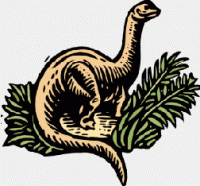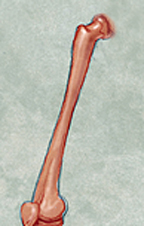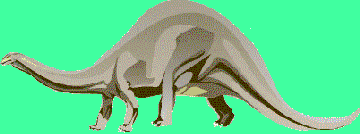Dinosaurs grow up
Learning how fast dinosaurs grew may help link birds to dinosaurs.
By Emily Sohn
One day, you realize that you can reach a shelf you could never get to before. Pretty soon, you’re buying new clothes every few months because the old ones are too short or too tight. Before you know it, you can stare directly into the eyes of your teachers and parents instead of looking up.
That’s a growth spurt, and these sudden surges upward happen to most kids at some time during adolescence. And, it turns out, dinosaurs probably went through the same sort of thing.

Using a new technique, scientists are figuring out how fast dinosaurs grew. Comparing the growth rates of dinosaurs with the growth rates of other animals may help us understand how and why we grow. The research may also shed light on one of the hottest topics in paleontology today: the origin of birds.
Bird evolution
Scientists have suggested that birds evolved from dinosaurs about 150 million years ago. Fossils provide some important clues. Most animals have solid bones. Birds, on the other hand, have hollow bones, as did meat-eating dinosaurs. Birds and dinosaurs also have similar skulls and teeth sockets in their jaws.
Another key piece of evidence linking birds to dinos came from Madagascar. In 1998, Catherine Forster, a paleontologist from the State University of New York at Stony Brook, found a fossil bird dating back 65 million to 70 million years. The bird had a sickle-shaped claw at the end of a thick second toe on its hind feet.
The only other known animals with such “killing claws” are dinosaurs such as velociraptors. You might recall seeing these slashing claws in action during the fierce velociraptor attacks in the movie Jurassic Park.
“This new fossil is one of the strongest last nails in the coffin of those who doubt that dinosaurs had anything to do with the origins of birds,” Forster told a reporter soon after she announced the discovery.
Paleontologists have also recently found feathers in sediments of old lakebeds in China and other places where dinosaurs lived. They now think that at least eight species of meat-eating dinosaurs had birdlike feathers, including the giant Tyrannosaurus rex.
“There’s pretty overwhelming evidence that birds are dinosaurs,” says paleontologist Gregory Erickson of Florida State University.
Growth rates
When it comes to growth rates, however, linking birds to dinosaurs is trickier. Certain types of birds are among the fastest growing animals alive today. Yet, we often think of dinosaurs as big reptiles, and today’s reptiles grow very, very slowly. Mammal growth rates fall somewhere in between. Humans grow more slowly than all other mammals.
If you wanted to figure out your own growth rate, you could measure your height or weigh yourself every few weeks or months. Then, you could plot your measurements on a graph with age along one axis and height or weight along the other. Connect the dots, and you would see how fast you’ve grown at different times in your life. You could even compare your own growth rate with the growth rates of your friends. Scientists do the same thing with animals to come up with standard growth tables.
Without baby dinos around for weekly weigh-ins, it seems impossible to know what a typical dinosaur’s growth chart would look like. However, fossil bones provide some clues.
You can tell how old a dinosaur was when it died by counting rings in its long bones. Each ring signals a year of growth, just like in a tree trunk.
It’s also possible to figure out how much an adult dinosaur weighed when it was alive. You simply measure the circumference of, or distance around, a big leg bone called the femur. For every animal, the ratio of femur circumference to weight is the same. Unfortunately, the equation doesn’t hold for animals that are still growing.

To find out how much kid dinosaurs weighed, Erickson looked for a different formula. His approach was somewhat untraditional.
Most paleontologists don’t think about living animals, Erickson says. His father had been a wildlife biologist, so Erickson ended up with a good understanding of what makes animals tick. For one thing, he learned how to find the ages of animals. Then he tried to figure out the missing piece: How animal weight changes during development.
Cracking the code
After studying how bones change in living animals as they grow, Erickson noticed a pattern. The length of the femur changes in proportion to an animal’s growth in weight. He was then able to come up with an equation that links body weight with bone length for dinosaurs of any age or size.
“We’re really kind of cracking the code right now,” Erickson says.
Using the method, Erickson and his colleagues have found that giant dinosaurs such as sauropods could grow by as many as 14 kilograms per day. That’s about as fast as a blue whale, today’s fastest growing mammal.

Smaller dinosaurs grew much more slowly. Yet, even the smallest dinosaurs grew at least twice as fast as modern-day reptiles. The biggest ones grew 56 times faster, says paleontologist Kristi Curry Rogers of the Science Museum of Minnesota in St. Paul.
These results further challenge the old notion that dinosaurs were just big lizards. In fact, human-sized dinosaurs probably grew a lot like we did, Erickson says.
Where might you fit in among dinosaurs? A troodon weighed about 60 pounds, a velociraptor about 45 pounds, and a protoceratops could grow to 120 pounds or so.
But there are big differences between our growth and that of the dinos, Erickson says.
For one thing, dinosaurs grew for only about 8 months out of the year. Kids can grow all year long. And while people often live into their 70s and 80s, dinosaurs rarely lasted longer than 20 years.
Fast growth
Erickson and his colleagues are most interested in comparing dinosaurs with birds. So far, none of the dinosaurs they have looked at grew as fast as today’s fastest growing birds.
The babies of birds that take care of their offspring after the eggs hatch tend to shoot up like rockets. “Nothing grows like them,” Erickson says. “Because their parents take care of them, they don’t waste energy. They just sit and eat like crazy, and they grow like crazy.”
The researchers are now analyzing modern-day bird bones for more clues about how birds evolved to grow so fast. Perhaps dinos gave them an initial boost.
Studying growth rates might help explain why some animals grow so much faster than others. For birds, it seems to make sense to shoot up right away. The sooner they reach adulthood, the better they are at avoiding predators.
Reptiles don’t normally face the same pressures, so they don’t need to put a lot of energy into growing quickly. Why we grow slowly sometimes and quickly at other times, however, is still a mystery.
Learning just about dinosaurs, birds, and evolution isn’t the only goal of his research, Erickson adds. If you consider that dinosaurs went extinct 65 million years before the first people even appeared on the planet, it’s amazing to think that we can actually learn so much about them, he says.
Research is like gathering clues to solve a mystery. “What’s important is that we show students how we go about figuring it all out,” Erickson says. Then, “they can say: ‘Wow! We can figure out almost anything.'”
The work also reinforces how unique dinosaurs really were. They weren’t just like lizards. They weren’t just like birds. Nor were they just like you. They were in a class all their own, Curry Rogers says. “They were just like dinosaurs.”







